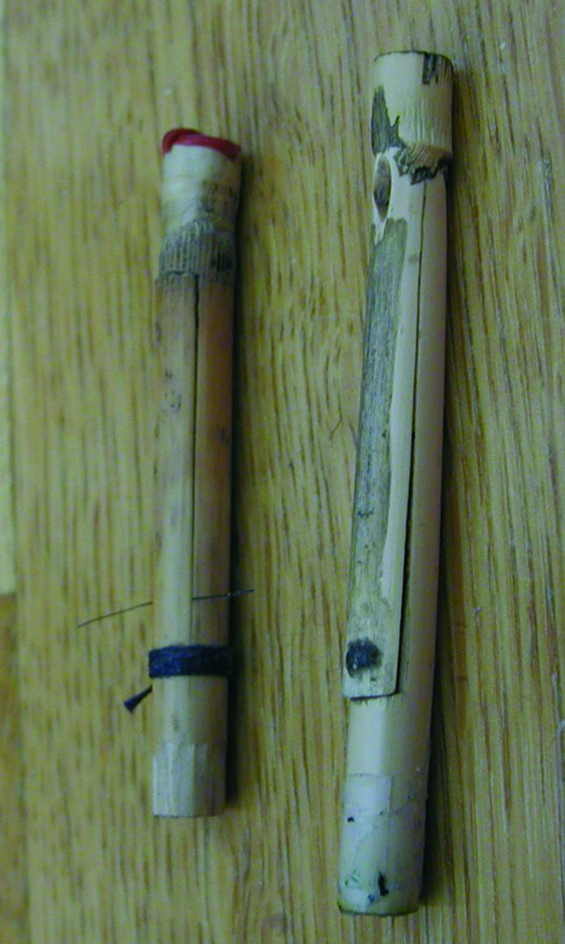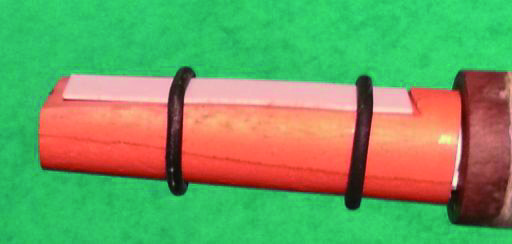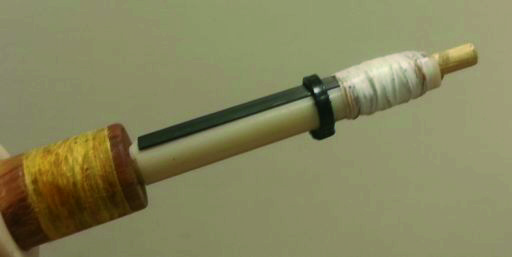The Bagpipe Society
Synthetic Chanter Reeds for Swedish Bagpipes
Swedish bagpipe reeds are traditionally made from the most suitable material growing in Sweden - Phragmites australis (common reed). Unfortunately Phragmites is a very fragile material and sensitive to humidity. Reed/tuning problems were most likely one of the main reasons that the instrument almost disappeared. Most active pipers today use imported cane, Arundo donax, the most common reed material for other reed instruments (including most other bagpipes). Arundo donax is harder and more resistant than Phragmites australis.

Even with Arundo donax reeds, however, many Swedish pipers struggle with their reeds on a daily basis. It is obviously a greater challenge to make single reeds work well for the full range of a chanter, than it is to make them work for the single note of a drone. This is a problem which the Swedish bagpipe has, or should have, in common with most East European bagpipes, but for some reason it seems to be worse for Swedish bagpipes. I can only speculate on why, but the narrow chanter bore, 6mm, might be one reason (possibly affecting stability). Another possible explanation is that many (most) Swedish bagpipe chanters were originally designed for Phragmites reeds. In any case, the full range of the chanter, a ninth or a tenth, is probably on the limit of what a single reed can handle, so the margins of error when making and adjusting reeds are very narrow.
Maybe for the same reason, it has turned out to be very difficult to make synthetic chanter reeds for Swedish bagpipes, i.e. reeds made from synthetic materials such as plastic or carbon fibre. A synthetic reed should be less sensitive to humidity and therefore more reliable in tuning and stability. Another advantage, which I think is almost as important for reliability, is that they should be easier to set up for consistent, perhaps even serial, production. With a reliable well-tuned reed, beginners could concentrate on learning how to play, instead of spending most of the time in frustration over misbehaving reeds, and it would make playing in groups a less painful experience.
However, it has been difficult to make synthetic reeds sound “right”, i.e. sufficiently close to natural reeds, and some would say that we are still not there. This is obviously subjective, and complicated by the fact that there is already a large sound variance among natural reeded Swedish bagpipes. In my opinion, the sound quality of synthetic reeds has now reached the point where they are within that variance. Not perfect, but close enough to make the practical advantages irresistible, to me and to a growing number of fellow pipers.
Synthetic reed tongues are not affected by moisture in the same way as cane, but this does not mean that they are trouble free. Though moisture cannot impregnate the tongue and thereby affect its stiffness, it can still affect its weight! If the humidity is high enough, the moisture may condensate and form small droplets on the tongue. If that happens, you will notice. On the other hand, you can then just wipe the tongue clean. (Cigarette paper is great for this - it’s thin enough to be inserted under the tongue to wipe that side as well..
Most of the usual tuning techniques for cane reeds should work also on synthetic reeds, but the tongue is often shorter than a corresponding cane reed which gives smaller margins of error when adjusting them. Also, even though cane reeds have their drawbacks, we’re used to them. Experienced pipers know what to do when things go bad. We don’t have that experience yet, with synthetic reeds, and the intended advantage that they don’t have to be messed with very often, gives us fewer opportunities to practice. So, when things do go wrong we may have lost our touch.
Below I describe the synthetic reeds made by three makers: Seth Hamon (USA), Matthias Branschke (Germany), and Max Persson (Sweden). These are not the only makers, but I would claim that they are currently the most influential in synthetic reed making for Swedish bagpipes.
Seth Hamon
I first came across the synthetic reeds (and bagpipes) made by Seth Hamon in the USA in 2011. I was giving workshops on Swedish bagpipes in Minneapolis and Seth Hamon, a bagpipe maker in Texas, kindly provided instruments on loan for the students. Both the ‘wooden’ parts of the instrument and the reed bodies are cast (!) in plastic resin and the reed tongues are cut from the kind plastic used in yogurt containers. The tongue is held in place by (movable) rubber rings.

Leaving the aesthetics (or lack thereof) of plastic instruments aside, they worked perfectly for their purpose. For the first time ever I could give bagpipe workshops without having to spend most of the time helping students with tuning issues. I spent less than an hour before the workshops tuning all the instruments, and that was it. After that they just worked. It was wonderful as a teacher, and surely also for the students, to be able to focus on playing techniques and styles during the workshop, instead of reed issues.
The sound, however, left some room for improvement. This is a matter of opinion of course, but there is to my ear a distinct sound difference between plastic reeds and cane reeds. They sounded ‘plastic’ (sic!) and they were a bit too strong (higher volume) compared to natural reeded Swedish bagpipes I played myself. But to a beginner I think it is more important to have a reliable instrument than that the sound is right.
I came home to Sweden with a bunch of plastic reeds and equipped one of my own instruments with them, to be used for practice and as a spare instrument, in case of emergencies during performances. This is the main advantage of Seth Hamon’s reeds, compared to the other two below. The reeds can be adjusted to work in most other Swedish bagpipes, not only the ones from Hamon’s own production. I adjusted mine for a set by Alban Faust. It took some time to get it right, Faust’s chanters are longer than Hamon’s, but it worked. The spare plastic reeds I got did indeed save two of my performances later that year.
The plastic tongue is soft and formable. You can bend the material to semi- permanent position, much like heat-setting cane reeds (but without applying the heat, obviously). So, there are many adjustments you can do, which is nice, but it is also a potential disadvantage. I do not expect two Hamon reeds to behave, or sound, exactly the same. The manufacturing of the reed body seems to be consistent, but the tongue and its tuning are not. The vibrating end of the tongue is very short compared to natural reeds, which means that small adjustments may have drastic effects. So, tuning them for the first time may be difficult, but once done it’s done.
Matthias Branschke
Later that same year, at the Chateau d’Ars festival in France, I met piper and pipe maker Matthias Branschke from Germany. His reed bodies are made of phenolic paper (or something very similar) which is a fibre reinforced plastic, very hard and moisture resistant, commonly used for printed circuit boards.

The big difference compared to Hamon’s reeds is the tongue, which in Branschke’s case is made from carbon fibre and is absolutely straight. The elevation of the tongue over the body is not forced by lifting or bending. Instead, the bed under the vibrating part of the tongue has been grinded down to the correct angle, once and for all. Branschke has developed a rig specifically for this, and can do it with very high precision. (Hamon’s reed bodies are also grinded down in a similar way, but the tongue can be, and in my experience often has to be, bent a little anyway. This, and its softness, makes the end result less predictable..
Having an almost fully machined body and a straight tongue, Branschke’s reed production is very consistent, which is crucial because his reeds are not adjustable at all! There is no bridle or hair to move. Everything is fixed in place. Even if you tried to bend the tongue as you would a cane or plastic tongue, it would just snap back to its straight position again. The (somewhat risky) assumption made here, is that with a sufficiently consistent manufacturing process you should not have to tune anything but the pitch of the whole scale (to compensate for temperature changes). That pitch is adjusted by simply pushing the reed further into the chanter, or pulling it out.
I must admit that this inflexibility made me very skeptical at first, but the sound of the carbon fibre tongue was so much better than plastic, so I was intrigued. Sound quality wise these reeds are closer to cane, and I dare say that most people will not hear any difference at all (and, even if so, not more than the previously mentioned variance which should be expected from cane reeded Swedish bagpipes anyway).
In December 2011 I was invited to teach a workshop at in Germany. More than half of the students turned out to have bagpipes with synthetic reeds and most of them were Branschke’s. Again, I was able to spend most of the time teaching music and playing techniques, and very little time on tuning. Teaching is so much more fun and rewarding under such conditions, and I have come back to give courses three times since.
The drawback is that Branschke had to redesign the chanter and the chanter stock to make this work, and his reeds therefore only work in his instruments. Also, if (however unlikely) you do have tuning or stability issues, you can’t do much about it, at least not the way you’re used to with cane reeds. I’m used to being able to solve my own reed problems. Having said that, I do play a Branschke set myself now, and apart from some initial issues when coming back to Sweden, due to climate differences, I’ve had no problems with it since. (Knock on fibre reinforced plastic..
Max Persson
Max Persson is currently the only professional maker in Sweden who makes synthetic reeds. His reeds are a kind of mix of the other two – Branschke’s sound combined with Hamon’s adjustability.
Persson’s reeds have a plastic body and a carbon fibre tongue. As far as I can tell the material of the tongue is exactly the same as that of Branschke’s reeds. The tongue is longer, however, and the reed dimensions are in fact very close to those of cane reeds. Like Branschke, Persson elevates the tongue from the body by grinding down the body at an angle, but he does so under the fixed end, causing the tongue to jut out a bit (though the angle is very small).

Persson’s reeds are adjustable. Unlike Branschke’s reeds, there is bridle to move. In addition, the closed end of the reed body is plugged by a movable peg which can be inserted further into, or pulled out from, the body. This affects the scale somewhat, but also the sound.
The reeds share the good sound qualities with Branschke’s. There is very little difference, if any. The adjustability of Persson’s reeds should be an advantage, but on the other hand Branschke’s reeds do not seem to require adjustments. I have noticed that pipers with Max Persson reeds do seem to adjust them more often than I do (or would if I could) with my Branschke reeds. There is a risk that adjustable reeds adjust themselves, I guess, but in Persson’s case I don’t think this is the most likely explanation. I think the main reason is psychological: Pipers tend to mess with their reeds, not because they have to, but because they can, and are used to having to do so with cane reeds. Playing a Branschke set myself I don’t have that choice, so I don’t.
Unfortunately, the adjustability of Max Persson’s reeds does not imply that they will work in other instruments. Like Branschke, Persson has redesigned the chanter and stock as well, not just the reeds. Seth Hamon’s reeds remain the only ones (so far) which can be adjusted to instruments made by others, and are therefore also the only ones which are sold separately. Indeed, several other makers are now, on request, selling instruments equipped with Set Hamon’s reeds.
The future
Sooner or later I think the synthetic reeds will replace cane for most of us. There will always be pipers, who prefer the old ways and materials of course, but to me the practical benefits of synthetic reeds are too great to ignore and the sound quality argument will not hold for much longer - not only because the quality will improve further, but because norms will move when most pipers play the new reeds. This has of course happened many times before, in Sweden and elsewhere.
More information on Swedish bagpipes, including links to all the makers mentioned in this article: http://olle.gallmo.se/sackpip.
- Data Processing Notice (GDPR)
-
@BagpipeSociety on X (formally known as Twitter)
-
TheBagpipeSociety on Instagram
-
 BagpipeSociety on Facebook
BagpipeSociety on Facebook
Something wrong or missing from this page? Let us know!
